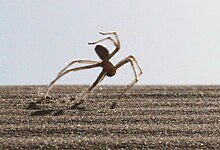Cebrennus rechenbergi
| Cebrennus rechenbergi | ||||||||||||
|---|---|---|---|---|---|---|---|---|---|---|---|---|

Cebrennus rechenbergi |
||||||||||||
| Systematics | ||||||||||||
|
||||||||||||
| Scientific name | ||||||||||||
| Cebrennus rechenbergi | ||||||||||||
| Hunter , 2014 |
Cebrennus rechenbergi is a spider belonging to the giant crab spider family. It is in the sand desert Erg Chebbi in Morocco endemic . The species became famous for its ability to move, which is unique for spiders. Her four pairs of legs allow her a movement that is reminiscent of a flick-flick and with which she can move, almost rolling, twice as fast as with her normal leg movement. Its discoverer, Ingo Rechenberg , therefore also called it “Radlerspinne”.
description
Cebrennus rechenbergi is a medium-sized giant crab spider. The body length of the specimens measured for the first description was 13.8 to 19.0 millimeters for the males and 19 to 19.5 millimeters for the females. Males and females are very similar in color. Their basic color is white, the scopula on the underside of the legs is black. The opisthosoma is dorsally yellowish in color and the thighs also appear yellowish. The chelicerae are yellowish brown, the claws dark.
distribution
Cebrennus rechenbergi occurs only in the Erg Chebbi sandy desert in the Errachidia province in the Meknès-Tafilalet region in south-east Morocco. The area is in the Sahara , near the border with Algeria . Cebrennus rechenbergi is one of 17 species of the genus Cebrennus , whose range extends over North Africa and the Arabian Peninsula to Central Asia .
Way of life
Cebrennus rechenbergi prefers - like most desert inhabitants - a nocturnal way of life. Before sunrise, the spider hunts butterflies, on which it mainly feeds. During the day, she crawls into a vertical, tubular structure in the sand, which is lined with spider silk.
Locomotion
The locomotion of Cebrennus rechenbergi is similar to that of the golden wheel spider ( Carparachne aureoflava ) in the Namib desert . The golden wheel spider from the south of Africa only uses its long legs to passively roll down a dune with the help of gravity . However, by actively using its legs, Cebrennus rechenbergi can accelerate rolling and even move up a slope. However, the energy expenditure for this movement work is considerable, so that the spider can lie dead after a long hunt.
Research history
Ingo Rechenberg , professor at the TU Berlin , discovered the spider in 2006 during a research stay in the Sahara , during which the surface properties and behavior of desert-dwelling organisms such as the "sand fish" Scincus albifasciatus were examined. The results of such observations can be used in bionics to develop technical systems based on biological principles. The studies of the behavior of Cebrennus rechenbergi led to the construction of various robots that can move around difficult terrain.
However, the spider could not initially be identified or described without a specimen copy. It wasn't until 2008 that two specimens were caught again and brought to Berlin. Peter Jäger from the Senckenberg Research Institute was able to identify a preserved specimen as a male of the genus Cebrennus . It was only after examining a female of the same species that Jäger could clearly determine that it was a new species of spider. Until then, it was assigned to the species Cebrennus villosus , known from Tunisia , which outwardly hardly differs from the species found in Morocco, but which lacks the possibility of rolling locomotion. The first description of the new species was only published in 2014. The species name rechenbergi honors the discoverer of the animal, the bionic scientist Ingo Rechenberg.
Web links
Cebrennus rechenbergi in the World Spider Catalog
- The rolling Sahara spider. In: Wissens-Magazin on Youtube from October 2, 2009, accessed on May 24, 2015
literature
- Peter Jäger : Cebrennus Simon, 1880 (Araneae: Sparassidae): a revisionary up-date with the description of four new species and an updated identification key for all species. In: Zootaxa. 3790, 2, pp. 319–356, 2014, ISSN 1175-5326 , doi: 10.11646 / zootaxa.3790.2.4 (first description)
Individual evidence
- ↑ Bec Crew: This Spider Rollin ', They Hatin': New Species of Cartwheeling Spider. Scientific American Blogs, dated April 30, 2014, accessed May 24, 2015.
- ↑ a b c d Peter Jäger: Cebrennus Simon, 1880 (Araneae: Sparassidae): a revisionary up-date with the description of four new species and an updated identification key for all species. In: Zootaxa 3790, 2, pp. 319–356, 2014, doi: 10.11646 / zootaxa.3790.2.4 (first description)
- ^ Cebrennus_rechenbergi. In: World Spider Catalog. Version 16, Natural History Museum Bern, 2015, accessed on May 24, 2015.
- ↑ a b Ralf Simon King: BiLBIQ: A Biologically Inspired Robot with Walking and Rolling Locomotion. Biosystems and Biorobotics, 2, Springer, Verlag, Berlin, Heidelberg 2013 ISBN 978-3-642-34681-1 , ISSN 2195-3562 , doi: 10.1007 / 978-3-642-34682-8 .
- ↑ Tabbot - Cyclist spider robot on Youtube from October 7, 2010, accessed on May 24, 2015
- ↑ Festo: BionicWheelBot. Walking and rolling like the cyclist spider , accessed on March 29, 2018


